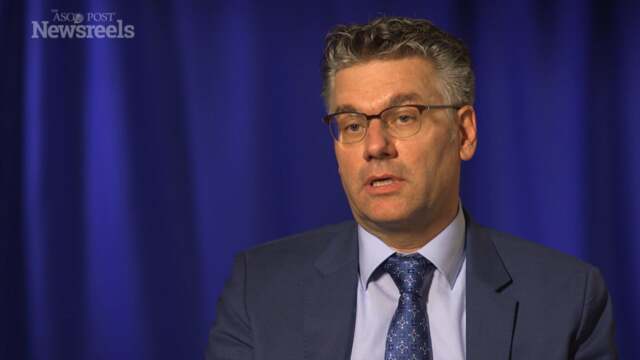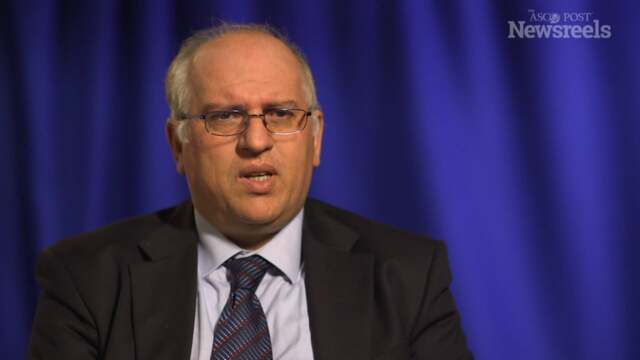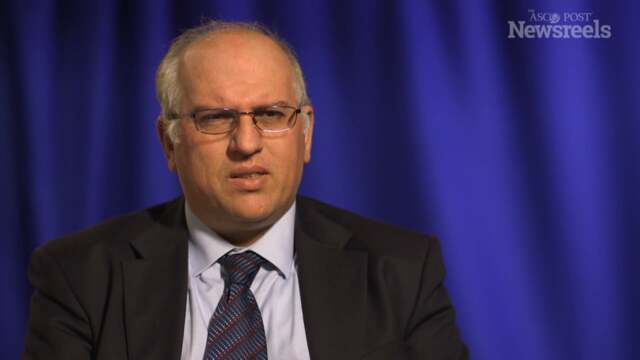Encouraging First Study of Pembrolizumab in Cutaneous T-Cell Lymphoma
Immunotherapy with an anti–programmed cell death protein 1 (PD-1) inhibitor—pembrolizumab (Keytruda)—showed encouraging responses in patients with advanced cutaneous T-cell lymphoma (either mycosis fungoides or Sézary syndrome). Pembrolizumab achieved a 38% overall response rate and responses...
Christian U. Blank, MD, PhD, on Melanoma: Initial Data From the OpACIN Trial (German Language Version)
Christian U. Blank, MD, PhD, of the Netherlands Cancer Institute, discusses in German study findings on neoadjuvant ipilimumab plus nivolumab in patients with palpable stage III melanoma. (Abstract LBA39)
Prospective Cutaneous Lymphoma International Prognostic Index Initiative Moves Forward
A collaboration of international experts is tackling the challenges involved in understanding and managing the treatment of cutaneous lymphomas. The Prospective Cutaneous Lymphoma International Prognostic Index (PROCLIPI) study from the Cutaneous Lymphoma International Consortium brings together...
High-Throughput Sequencing of T-Cell Receptors May Transform Diagnosis and Treatment of Cutaneous T-Cell Lymphomas
High-throughput sequencing of T-cell receptors may be a solution to some of the challenges confronting oncologists who treat cutaneous T-cell lymphomas. According to experts who presented talks on high-throughput sequencing of T-cell receptors at the 3rd World Congress of Cutaneous Lymphoma...
Fulminant, Fatal Myocarditis Reported in Two Patients After Starting Combined Immune Checkpoint Blockade Treatment
In an article in The New England Journal of Medicine, Johnson et al reported the occurrence of fulminant, fatal immune-related myocarditis in two patients who received combined ipilimumab (Yervoy) and nivolumab (Opdivo) for metastatic melanoma. Patient Courses One patient was a 65-year-old woman...
SITC 2016: Phase I/II Data Combining Urelumab With Nivolumab Suggest Increased Antitumor Effect in Patients With Melanoma
Safety and efficacy data from a phase I/II study of urelumab in combination with nivolumab (Opdivo) in patients with hematologic and solid tumors, including biomarker analyses by level of programmed death ligand 1 (PD-L1) expression, was recently presented at the Society for Immunotherapy of Cancer ...
Study Suggests Benefit of Adjuvant Radiation Therapy but Not Chemotherapy in Some Patients With Merkel Cell Carcinoma
In an analysis of National Cancer Data Base data reported in the Journal of the National Cancer Institute, Shailender Bhatia, MD, of the University of Washington/Fred Hutchinson Cancer Research Center, and colleagues found that adjuvant radiotherapy was associated with a survival benefit in...
Study Looks for Optimal Dosing of Single-Agent Ipilimumab in Metastatic Melanoma
There has been debate as to the optimal dose of single-agent ipilimumab (Yervoy) in metastatic melanoma. A phase III study presented at the 2016 European Society for Medical Oncology (ESMO) Congress—the first to directly compare these doses—concluded that 10 mg/kg is more effective, but also more...
Small Study Tests Dual Checkpoint Blockade in High-Risk Stage III Melanoma
As neoadjuvant or adjuvant therapy for stage III melanoma patients with palpable disease, the combination of ipilimumab (Yervoy) plus nivolumab (Opdivo) was shown to be a promising, though also toxic, combination in a phase Ib study reported at the 2016 European Society for Medical Oncology (ESMO) ...
Combination Strategies Harness the Power of the Oncolytic Virus Talimogene Laherparepvec
The injectable oncolytic immunotherapy talimogene laherparepvec (also known as T-VEC, Imlygic) may become a valuable component of combination immunotherapy approaches in melanoma, a strategy believed to help overcome resistance of tumors to single-agent immunotherapies. “[Talimogene laherparepvec] ...
Gut Microbes Linked to Immunotherapy Response in Patients With Melanoma
Patients with malignant melanoma are more likely to respond to immunotherapy treatment if they have greater diversity in their gut bacteria, according to new research presented by Wargo et al at the National Cancer Research Institute's (NCRI) Cancer Conference in Liverpool, United Kingdom....
Psychoeducational Intervention Reduces Fear of Melanoma Recurrence in Patients With High-Risk Melanoma
In an Australian trial reported in the Journal of Clinical Oncology, Dieng et al found that use of a psychoeducational intervention reduced the fear of cancer recurrence and stress among patients at high risk of developing a second primary melanoma. Study Details In the trial, 164 patients from 3 ...
Personalized Vaccines May Protect Patients With High-Risk Melanoma
The field of cancer vaccines may be reinvigorated by a new understanding, and the therapeutic leveraging, of neoantigens. Researchers from Dana-Farber Cancer Institute in Boston are exploring this novel approach as a means of protecting patients with high-risk melanoma from recurrence. Early...
Association of PD-L1 Expression and Response to Pembrolizumab in Advanced Melanoma
In an analysis from the phase IB KEYNOTE-001 trial, Daud et al found that the level of programmed cell death ligand 1 (PD-L1) expression was associated with outcomes of pembrolizumab (Keytruda) treatment in patients with advanced melanoma. These findings were reported in the Journal of Clinical...
Adjuvant Ipilimumab Improves Survival in High-Risk Melanoma
Patients with stage III melanoma who were considered to be at high risk for recurrence derived an overall survival benefit from adjuvant treatment with ipilimumab (Yervoy), although it came at the price of considerable toxicity, according to updated survival results from the phase III European...
ESMO 2016: Pooled Analysis Shows PD-L1 Expression as a Biomarker for Nivolumab Plus Ipilimumab Response in Advanced Melanoma
A pooled analysis from three clinical trials in advanced melanoma shows that although patients treated with nivolumab and nivolumab plus ipilimumab with ≥ 5% programmed death-ligand 1 (PD-L1) tumor expression have similar progression-free survival, durable response rates were higher for the...
Modification of Dosage Regimen for Nivolumab in Renal Cell Carcinoma, Melanoma, and NSCLC
In the Clinic provides overviews of novel oncology agents, addressing indications, mechanisms, administration recommendations, safety profiles, and other essential information needed for the appropriate clinical use of these drugs. On September 13, 2016, the U.S. Food and Drug Administration...
Investigational Immunotherapy Appears Safe and Somewhat Active in Advanced Melanoma
The investigational immunotherapeutic IMC-20D7S was found to be well tolerated and somewhat active in patients with advanced melanoma, including one complete response, according to the results of a phase I/Ib trial reported by Khalil et al in Clinical Cancer Research. IMD-20D7S is a...
Adjuvant Ipilimumab Prolongs Survival in High-Risk Stage III Melanoma, Phase III Study Reports
In the phase III European Organisation for Research and Treatment of Cancer (EORTC) trial 18071 reported at the recent European Society for Medical Oncology meeting and in The New England Journal of Medicine by Eggermont et al, adjuvant ipilimumab (Yervoy) was found to improve recurrence-free and...
Paolo A. Ascierto, MD, on Metastatic Melanoma: Ipilimumab Study Results (Italian Language Version)
Paolo A. Ascierto, MD, of the Istituto Nazionale Tumori–Fondazione Pascale, discusses in Italian overall survival and safety results from a phase 3 trial of ipilimumab at 3 mg/kg vs 10 mg/kg in patients with metastatic melanoma. (Abstract 1106O)
ESMO 2016: Ipilimumab as Adjuvant Therapy Improves Overall Survival in High-Risk Stage III Melanoma
Ipilimumab (Yervoy) as adjuvant therapy significantly improves overall survival in patients with high-risk stage III melanoma, according to the European Organisation for Research and Treatment of Cancer (EORTC) 18071 phase III trial results presented by Eggermont et al at the European Society for...
Alexander Eggermont, MD, PhD, on Melanoma: Results From the EORTC 18071 Trial
Alexander Eggermont, MD, PhD, of Gustave Roussy, discusses final overall survival findings on ipilimumab vs placebo after complete resection of stage III melanoma. (Abstract LBA2)
Christian U. Blank, MD, PhD, on Melanoma: Initial Data From the OpACIN Trial
Christian U. Blank, MD, PhD, of the Netherlands Cancer Institute, discusses study findings on neoadjuvant ipilimumab plus nivolumab in patients with palpable stage III melanoma. (Abstract LBA39)
Paolo A. Ascierto, MD, on Metastatic Melanoma: Ipilimumab Study Results
Paolo A. Ascierto, MD, of the Istituto Nazionale Tumori–Fondazione Pascale, discusses overall survival and safety results from a phase III trial of ipilimumab at 3 mg/kg vs 10 mg/kg in patients with metastatic melanoma. (Abstract 1106O)
Omid Hamid, MD, on Melanoma: Results From the KEYNOTE-002 Study
Omid Hamid, MD, of The Angeles Clinic and Research Institute, discusses survival data from this clinical trial on pembrolizumab vs investigator-choice chemotherapy for ipilimumab-refractory melanoma. (Abstract 1107O) Follow him on Twitter: @omidhamidmd
Ratio of Certain Immune Cells in the Blood to Tumor Burden Correlated With Outcome for Melanoma Patients Treated With Pembrolizumab
Although some patients with melanoma experience durable responses to treatment with the anti–PD-1 (programmed cell death protein 1) therapy pembrolizumab (Keytruda), the majority of patients do not experience a durable clinical benefit from anti–PD-1 monotherapy, according to a study by ...
Combining AM0010 and Pembrolizumab Produced Antitumor Activity in Patients With Advanced Solid Tumors
A multibasket phase Ib study evaluating the clinical activity, tolerability, and antitumor activity of the cytokine-based immunotherapy AM0010 alone or in combination with the immune checkpoint inhibitor pembrolizumab (Keytruda) has found that in monotherapy, objective responses to AM0010 were ...
Study Confirms Benefit of Cobimetinib Plus Vemurafenib in Advanced BRAF V600–Mutant Melanoma
As reported by Ascierto et al in The Lancet Oncology, longer-term follow-up in the pivotal phase III coBRIM trial confirmed the benefit of adding cobimetinib to vemurafenib (Zelboraf) in first-line treatment of BRAF V600–mutant unresectable stage IIIC or IV melanoma. Grant A. McArthur, FRACP, of...
Combining Ipilimumab With Radiotherapy in Advanced Melanoma
The immunotherapy ipilimumab (Yervoy) has revolutionized the treatment of malignant melanoma and resulted in durable responses in 20% to 25% of patients with the cancer. Sebastian Theurich, MD, of the Center for Integrated Oncology at the University Hospital of Cologne in Germany, and colleagues...
Nonwhite Organ Transplant Recipients Also at Heightened Risk for Skin Cancer
A new study from Drexel University College of Medicine suggests all organ transplant recipients, regardless of race, should receive routine, total-body screenings for skin cancer. Out of 259 nonwhite transplant recipients who were evaluated in the study, 19 skin cancer lesions were identified in...
‘Encouraging Survival Outcomes’ Reported With Combined Nivolumab and Ipilimumab in Advanced Melanoma
Hodi et al found “encouraging survival outcomes” with the addition of nivolumab to ipilimumab in patients with previously untreated unresectable stage III or IV melanoma, according to 2-year overall survival data in the phase II CheckMate 069 trial. These results were reported in The...
FDA Modifies Dosage Regimen for Nivolumab
On September 13, 2016, the U.S. Food and Drug Administration (FDA) modified the dosage regimen for nivolumab (Opdivo) for the currently approved indications for renal cell carcinoma, metastatic melanoma, and non–small cell lung cancer (NSCLC). The currently approved recommended dosage...
Durable Responses Reported With Avelumab in Chemotherapy-Refractory Metastatic Merkel Cell Carcinoma
In a phase II trial reported in The Lancet Oncology, Kaufman et al found that the anti–PD-L1 (programmed cell death ligand 1) monoclonal antibody avelumab produced durable responses in patients with stage IV Merkel cell carcinoma progressing after cytotoxic chemotherapy. Study Details In...
Study Suggests Benefit of Adjuvant Radiation Therapy but Not Chemotherapy in Some Patients With Merkel Cell Carcinoma
In an analysis of National Cancer Data Base data reported in the Journal of the National Cancer Institute, Bhatia et al found that adjuvant radiotherapy was associated with a survival benefit in patients with stage I and II but not stage III Merkel cell carcinoma, with no benefit of adjuvant...
Clinical Trials Actively Recruiting Patients With Basal Cell Carcinoma
Study Title: Long-Pulsed 1064 nm Nd:YAG Laser Treatment of Basal Cell Carcinoma (BCC) Study Type: Interventional/single-group assignment Study Sponsor and Collaborators: University of California, San Diego; Massachusetts General Hospital Purpose: To evaluate the safety and efficacy of laser...
Management of Merkel Cell Carcinoma
A recent report regarding pembrolizumab (Keytruda) for advanced Merkel cell carcinoma ushered in a more optimistic era in the treatment of this rare but often lethal skin cancer.1 The ASCO Post spoke with one of the field’s leaders, Paul Nghiem, MD, PhD—the first author of the study—about the...
Immune Analysis of On-Treatment Longitudinal Biopsies Predicts Response to Melanoma Immunotherapy
Immune response measured in tumor biopsies during the course of early treatment predicts which melanoma patients will benefit from specific immune checkpoint blockade drugs, researchers at The University of Texas MD Anderson Cancer Center found in a report published by Chen et al in Cancer...
Incidence of PD-1 Inhibitor–Related Pneumonitis in Advanced NSCLC, Renal Cell Carcinoma, and Melanoma
In a systematic review and meta-analysis reported in JAMA Oncology, Nishino et al identified the rates of PD-1 (programmed cell death protein 1) inhibitor–related pneumonitis in patients with advanced non–small cell lung cancer (NSCLC), renal cell carcinoma, and melanoma. Rates were...
Melanoma MicroRNA Trafficking May Control Tumor Primary Niche Formation
Researchers at Tel Aviv University (TAU) may have unraveled the metastatic mechanism of melanoma. According to a paper published by Dror et al in Nature Cell Biology, scientists discovered that before spreading to other organs, a melanoma tumor sends out tiny vesicles containing molecules of...
Pembrolizumab for Untreated/Progressive Brain Metastases in Melanoma or NSCLC
Sarah B. Goldberg, MD, of Yale University School of Medicine, and colleagues found that pembrolizumab (Keytruda) was active in untreated or progressive brain metastases in melanoma and non–small cell lung cancer (NSCLC), according to a single-center phase II trial reported in The Lancet Oncology....
Immune Analysis of On-Treatment Longitudinal Biopsies Predicts Response to Melanoma Immunotherapy
Immune response measured in tumor biopsies during the course of early treatment predicts which melanoma patients will benefit from specific immune checkpoint blockade drugs, according to researchers at The University of Texas MD Anderson Cancer Center. Chen et al reported their findings in...
Study Confirms Benefit of Cobimetinib Plus Vemurafenib in Advanced BRAF V600–Mutant Melanoma
As reported by Ascierto et al in The Lancet Oncology, longer-term follow-up in the pivotal phase III coBRIM trial confirmed the benefit of adding cobimetinib to vemurafenib (Zelboraf) in first-line treatment of BRAF V600–mutant unresectable stage IIIC or IV melanoma. Study Details In the...
Study Identifies Novel Treatment Resistance Mechanism in BRAF-Mutant Melanoma
A Massachusetts General Hospital (MGH) research team has identified an additional mechanism for resistance to targeted treatment for BRAF-mutant melanoma. Their findings, published by Shen et al in Nature Medicine, report that inactivating mutations in two genes responsible for regulating key...
Ipilimumab Combined With Antigen-Specific Cytotoxic T Lymphocytes in Metastatic Melanoma
In a study reported in the Journal of Clinical Oncology by Chapuis et al, concurrent use of cytotoxic T lymphocyte (CTL) antigen-4 (CTLA-4) blockade with ipilimumab (Yervoy) and adoptively transferred antigen-specific CTLs produced enduring responses in patients with stage IV melanoma. Cassian Yee, ...
Potential Link Between Pembrolizumab Use and Demyelinating Polyradiculoneuropathy Reported in Two Cases of Advanced Melanoma
In a letter to the editor in The New England Journal of Medicine, de Maleissye et al described two cases of severe demyelinating polyradiculoneuropathy that occurred after pembrolizumab (Keytruda) treatment for advanced melanoma. Case 1 A 45-year-old woman receiving pembrolizumab at 2 mg/kg every ...
Combining Ipilimumab With Radiotherapy or Electrochemotherapy May Prolong Survival in Patients With Advanced Melanoma
The immunotherapy ipilimumab (Yervoy) has revolutionized the treatment of malignant melanoma and resulted in durable responses in 20% to 25% of patients with the cancer. A study by Theurich et al investigating the benefits of combining ipilimumab with local peripheral treatments, such as...
Pathway Defects in Acquired Resistance to PD-1 Inhibition in Melanoma Identified
In a study reported in The New England Journal of Medicine, Zaretsky et al found that defects in interferon receptor signaling and antigen-presenting pathways were associated with acquired resistance to PD-1 (programmed cell death protein 1) inhibition in melanoma. Resistance Mutations Identified ...
USPSTF Issues Final Recommendation Statement on Screening for Skin Cancer
The U.S. Preventive Services Task Force (USPSTF) has concluded that the current evidence is insufficient to assess the balance of benefits and harms of visual skin examination by a clinician to screen for skin cancer in asymptomatic adults. The report was published in JAMA. This is an “I...
Studies Suggest Bright Future for Combination Immunotherapy in Advanced Melanoma, but Questions Remain
Two studies presented at the 2016 ASCO Annual Meeting focused on the use of combination immunotherapy in the treatment of patients with advanced melanoma. Updated results from the phase III CheckMate 067 trial centered on the combination of nivolumab (Opdivo) plus ipilimumab (Yervoy) compared...
Ipilimumab Combined With Antigen-Specific Cytotoxic T Lymphocytes May Be of Benefit in Metastatic Melanoma
In a study reported in the Journal of Clinical Oncology by Chapuis et al, concurrent use of cytotoxic T lymphocyte (CTL) antigen-4 (CTLA-4) blockade with ipilimumab (Yervoy) and adoptively transferred antigen-specific CTLs produced enduring responses in patients with stage IV melanoma. Study...






